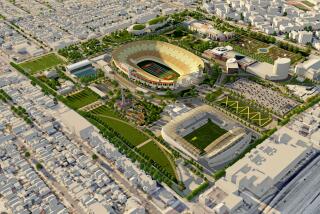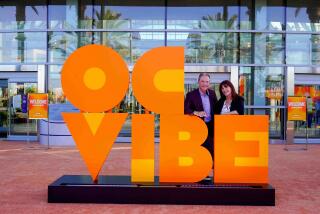Putting the green in Orange County Great Park
- Share via
The first memory Emile Haddad has of what would become the site of the Orange County Great Park and the location of his biggest development project dates from 1986, not long after he and his family fled their home in Lebanon.
Then it was still the El Toro Marine Corps Air Station, and as he tried to make a phone call from the roadside the quiet was shattered by the sound of an F/A-18 fighter jet screaming overhead.
Haddad, 51, had grown up amid the nearly constant bloodshed of a sectarian Beirut, and his first instinct was to hit the ground. “I still had the Lebanese mind-set,” he says.
The jet engines have been stilled, but that doesn’t mean the noise level around the site has fallen. Once the Pentagon announced the base would be decommissioned in 1999, surrounding communities started to squabble about how to put its nearly six square miles of Irvine real estate to use.
Four referendums ensued, including two that asked voters to weigh in on plans to turn the base into a commercial airport. The airport idea prevailed in the first vote and died in the second; at that point the plans shifted to the creation of a regional park of about two square miles, surrounded by private development.
Yet as Haddad recognizes, “the politics of Great Park will never be over. This is a politically divided city, and the park is a great thing for people to debate with each other.”
Haddad today is managing the site’s development as principal of Five Point Communities, a development spinoff of Miami-based home builder Lennar Corp., which acquired the shuttered base in 2005 for about $1 billion. A complicated life path got him to this point. He was raised in a middle-class Greek Orthodox home in Beirut, where his father was a corporate executive and his mother, a banker.
By 1986 he had graduated from the American University in Beirut with a civil engineering degree, but the city’s sectarian violence made it unlivable.
“People were dying in front of me all the time,” Haddad, a tall, fit man recalls in his lightly accented English. That year his family fled, leaving behind all their possessions, and fetched up in the San Fernando Valley.
Haddad eventually landed a job with Lennar and rose to become its West Coast development chief and chief investment officer. Earlier this year Lennar spun off several Lennar projects, including El Toro and the Newhall Ranch projectnearValencia, into Five Point. Lennar kept a 60% stake and ceded Haddad operational control.
By then the El Toro development had already become an exercise in keeping a mixed-use project moving when its basic economic assumptions are upended.
The real estate crash “threw us a curveball,” he told me when we met at the park site recently. “We needed to look at how to move forward with the development, knowing that the residential market has no visibility.” (That’s the phrase businesspeople use when the future’s plenty visible but looks grim.) “We were supposed to be selling homes there by 2007; now I don’t think I’ll be selling homes until 2013.”
The cost and pace of work on the project, which at the moment consists of a tethered balloon ride and a small “preview” park, have been the subject of nearly ceaseless political bickering, not least because the ultimate price tag has, well, ballooned to nearly $1.4 billion. About a third of that money was supposed to be financed through residential and commercial development undertaken by Haddad’s firm.
Real estate market conditions prompted a renegotiation of the development agreement with the city of Irvine, which called for construction of 3,600 homes on the site and included plans for 45 holes of golf (two courses of 18 holes and one of nine). The developer was to front the city about $400 million in cash and infrastructure improvements as construction proceeded.
The new deal, approved by the Irvine City Council late this summer, scraps the golf courses along with a 171-acre agricultural preserve, and requires Haddad to put up $58 million for site improvements in the next three to five years -- in effect, guaranteeing infrastructure development regardless of how the real estate market fares over that time.
The council simultaneously approved an expansion of the residential limit to about 4,900 homes, including about 500 affordable units, and it prepared to move ahead with the first phase of park construction, an athletics center with playing fields for soccer and other sports in the southwest corner of the old base.
The renegotiation provided an opportunity for the park’s opponents and skeptics to raise persistent issues about the project. As one would expect, Haddad’s view is that opponents harbor unrealistic expectations.
“This is an amenity that’s going to be built over many, many years,” he says. “Everybody thinks we can build a park that’s twice the size of Central Park and it’s all going to happen in one year. What we’re hearing from people now is that all they want is to see something” -- hence his agreement to guarantee that the infrastructure spending will take place in the near term.
As we strolled about the site one day recently, Haddad told me he thought the new plan was much more rational than the old. We were walking along what had been the air station’s main runway, now a strip of weed-infested macadam running past a line of derelict aircraft hangars.
The park designers plan to convert the runway into a bucolic pedestrian path linking two of Haddad’s residential and commercial parcels. Picturing the ultimate result amid mounds of concrete refuse and rusted steel required an act of imagination, much as the great English landscape architect Capability Brown might have designed an estate’s garden in 1760 by imagining what it would look like when the trees were grown in 50 or 100 years.
“We created a better mix” of uses, he says. The original residential limitation, imposed by a growth-wary community, was too meager, he argues -- roughly a fifth of Irvine’s existing average density. That would have driven up the average price of Great Park homes to unmarketable levels. Homes in Haddad’s planned first phase will sell in the $400,000-$750,000 range, and he expects the average price to be about $600,000 when the project is built out.
What he described was something very different from the quintessential automobile-oriented suburb erected here by Irvine Co. over the last half-century, with single-family homes or town homes clustered together, separated by broad thoroughfares from shopping centers and by freeways from the residents’ jobs. Haddad’s vision more resembled a European population center -- or even one resembling the Beirut of his youth -- that not only places home and commerce in walking proximity to one another but supports a heterogeneous socioeconomic residential mix.
“The two highest-growth population segments today are 55-plus and generation Y [that is, those now in their late 20s or early 30s],” he says.
“They have more in common than you’d think. They don’t want to go to suburbia. So we want to create a new element here.”
What he has in mind, he says, is “a mixed-use, higher-density retail and entertainment area here, where the runway becomes an element attracting people to walk. We have to train people to stay out of their cars.”
That may be the most ambitious element of Haddad’s plan. But the Great Park parcel is one of the last few large tracts in Southern California close to metropolitan centers and available for development from the ground up.
Whatever one might think about the plausibility of Haddad’s proposal to create what amounts to a green community where the car is an amenity rather than a necessity, where residents from all walks of life live together and satisfy their commercial needs on foot, if he pulls it off that will be a great achievement.
Michael Hiltzik’s column appears Mondays and Thursdays. Reach him at [email protected], read earlier columns at www.latimes.com/hiltzik, and follow @latimeshiltzikan estate’s garden on Twitter.
More to Read
Sign up for Essential California
The most important California stories and recommendations in your inbox every morning.
You may occasionally receive promotional content from the Los Angeles Times.











